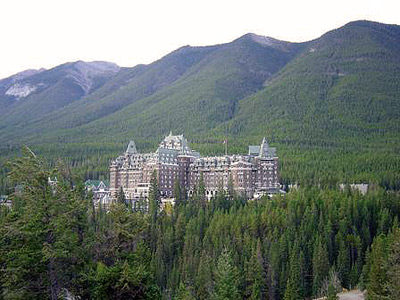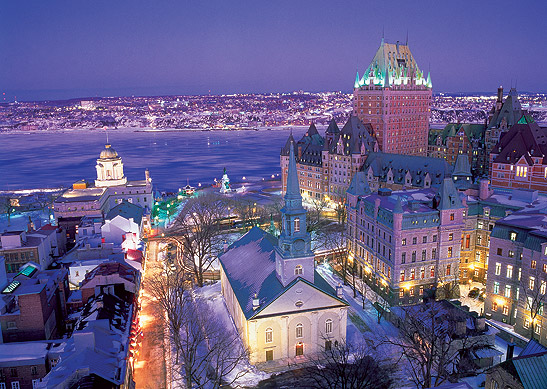 Le Château Frontenac dominates
the Québec City skyline. Courtesy: Québec
Tourism
Le Château Frontenac dominates
the Québec City skyline. Courtesy: Québec
Tourism
Four Historic Hotels
By Ringo Boitano
“The great advantage of a hotel is that it is a refuge from
home life.”
- George Bernard Shaw
“This is an elegant hotel! Room service has an unlisted number.”
- Henny Youngman
 hotel is a lot like a person. Both are living and breathing entities
with experiences that are uniquely their own. Like a person, a hotel
is full of memories. They have histories that only they can understand.
First impressions are important. Sometimes the façade is misleading,
with an interior offering no substance; at other times it only gets
better inside. Sometimes it takes time to appreciate. Like a person,
a hotel requires maintenance – it needs to have its pipes cleaned
and its windows washed. Often time major renovations are required just
so that it will be able to function. While some properties age gracefully,
others have facelifts in an attempt to adapt to the styles of the day.
Returning to a favorite hotel can be akin to visiting an old friend.
As we age and grow, so, too, does the hotel – and it shows us how
we too have changed throughout the years.
hotel is a lot like a person. Both are living and breathing entities
with experiences that are uniquely their own. Like a person, a hotel
is full of memories. They have histories that only they can understand.
First impressions are important. Sometimes the façade is misleading,
with an interior offering no substance; at other times it only gets
better inside. Sometimes it takes time to appreciate. Like a person,
a hotel requires maintenance – it needs to have its pipes cleaned
and its windows washed. Often time major renovations are required just
so that it will be able to function. While some properties age gracefully,
others have facelifts in an attempt to adapt to the styles of the day.
Returning to a favorite hotel can be akin to visiting an old friend.
As we age and grow, so, too, does the hotel – and it shows us how
we too have changed throughout the years.
While staying at the following hotels, one cannot help
but feel the presence of events past -- so here’s a fun way to
look at them.
The
Fairmont Banff Springs
The Scene:
Modeled after a Scottish baronial castle, the opulent Fairmont Banff
Springs is like its own bustling village, hidden in the spectacular
Canadian Rocky Mountains. An adult Disneyland comes to mind with its
army of impeccably uniformed staff, mammoth ballrooms, elegant restaurants,
stately lounges, designer shops and its recently renovated European-style
spa. If activities are what you desire, this world-class resort is the
hub.
The Backstory:
'If we can't export the scenery, we will import the tourists' was the
self-fulfilling prophesy of William Van Horne, General Manager of the
Canadian Pacific Railway, who recognized the tourist potential of the
hot springs near the railway station at Banff, Alberta. His vision was
to design a luxury hotel amidst the stunning mountain scenery of the
Canadian Rockies – and the only way to get there in 1886 would
be via a railway.
The Look:
Van Horne commissioned Bruce Price of New York, one of the foremost
architects of the day, to draw up plans for a hotel to be built above
the confluence of the Bow and the Spray Rivers overlooking the beautiful
Bow Valley. They looked to European castles and manor houses for their
inspiration. The hotel officially opened on June 1, 1888, and was declared
a historical site by the Sites and Monuments Board of Canada in 1992.
Most Unique Amenity:
Perhaps the only dilemma while staying at the Banff Springs is what
to do next. A case can be made for enjoying the property’s endless
amenities or for exploring the endless majesty of the Canadian Rockies.
How about a hybrid - the “Cruising the Canadian Rockies” package
includes accommodations, rental car and a road trip essentials pack
containing a CD with a descriptive narrative of the journey. End your
day with a plunge in the world-famous hot springs or with a treatment
at the European-style spa.
If Walls Could Talk:
In 1956, Marilyn Monroe was staying at the hotel while filming River
of No Return, directed by Otto Preminger. During the filming, she
sprained her ankle and was on doctor's orders to be transported in a
wheelchair. Needless to say, fierce arguments broke out among the bellmen
as to who would get to push Ms. Monroe around the hotel. The dilemma
was handled in the only civilized way – each morning the young
men drew straws.
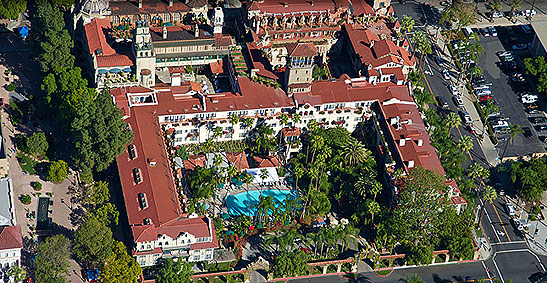
Courtesy: The Mission Inn
The Mission Inn
The Scene:
The Mission Inn occupies an entire city block in downtown Riverside,
California and is a national historic and architectural landmark. The
inn offers 239 guest room and suites, many with architectural features
such as domed ceilings, wrought iron balconies, stained glass windows
and carved pillars. The inn has been a getaway for personalities as
diverse as Albert Einstein, Theodore Roosevelt, Charles Chaplin and
Sarah Bernhardt.
The Backstory:
The Inn began as a 12-room adobe boarding house, built in 1876 by Christopher
Columbus Miller, on land deeded to him by the city as payment for his
services as civil engineer. By the turn of the century, Riverside was
already a major tourist attraction for wealthy easterners and for Europeans
escaping to warm winter climates and seeking investment opportunities
in the profitable citrus industry. What the city lacked, though, was
a major tourist hotel.
The Look:
Frank Augustus Miller purchased the property from his father, improved
and enlarged it, and by 1903 opened the first wing of the current Mission
Inn building. Over the next thirty years Miller added additional wings
to the structure that included the Music Room, St. Cecilia Chapel, the
Catacombs and the Spanish Patio. More than anything, the Mission Inn
is an artful and architectural tribute to the vision, eclecticism, and
eccentricity of Frank Miller.
Most Unique Amenity:
In 1909, President Howard Taft made plans to visit the hotel. Miller
was worried that his chairs would not accommodate Taft's weight, reported
at 350 lbs, so he constructed an enormous oak chair, with the overall
width of 48-1/2 inches. Upon seeing the creation, the vain Taft replied,
"Did you have to make the chair so large?” The Taft chair
is the most famous of the nearly 400 chairs in the Mission Inn collections,
and rests in the lobby. The hotel also boasts a noteworthy collection
of ornamental and musical bells.
If Walls Could Talk:
Paul Newman was a frequent guest at the inn. His room of choice was
the Bridal Suite, a large round room with a domed ceiling. Once, upon
arrival, he was informed that the room’s plumbing was out. Newman
still wanted to stay in the room and agreed to use another bathroom,
which would require going outside to reach the other room. Word spread
quickly, and a mob of the hotel’s female staff assembled in the
courtyard below, hoping to catch a glimpse of the Hollywood heartthrob
in his bathrobe enroute to the other room.
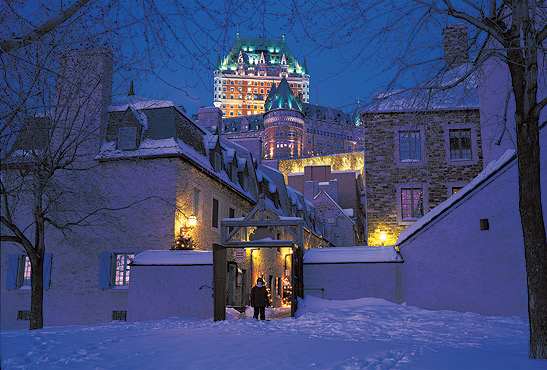
Courtesy: Québec Tourism
Fairmont
Le Château Frontenac
The Scene:
Situated on a bluff overlooking the sweeping St. Lawrence River, Fairmont
Le Château Frontenac is more than a hotel - it is quite literally
the symbol of Old Québec. The castle-like property, with its
majestic towers and turrets, evokes an era of time-gone-by, yet still
serves as a center for what is Old Québec today. With the boardwalk
in front of it and the city to its rear, Le Château offers easy
walking access to the array of attractions throughout Québec
City, a United Nations World Heritage Site.
The Backstory:
In the late 19th century, William Van Horne of the Canadian Pacific
Railway continued his theme of building hotels as the ideal stopover
for railway travelers. But Le Château Frontenac soon became much
more than that; it became a destination unto itself - a true-life castle
of many people's dreams. It is now a landmark known throughout the world.
The Look:
Once again Van Horne retained the services of New York architect Bruce
Price who this time drew on the architectural styles of the Middle Ages
and Renaissance. The property owes its name to French governor, Louis
de Buade, Count of Frontenac, whose coat-of-arms can be seen on the
entry arch and many other areas within the hotel. Throughout the years
a series of expansions have taken place and today Le Château towers
even higher over Old Québec.
Most Unique Amenity:
Québec City boasts more restaurants per ratio than any other
city in North America, and the quality is proudly on display at Le Château's
four restaurants. Few people know, however, that Executive Chef Jean
Soulard's dishes are delicately seasoned with fresh herbs that are grown
in his own garden - nestled atop Le Château's roof. The garden
is available exclusively to the Chef (and a gardener) and can only be
accessed through a window!
If Walls Could Talk:
Countless personalities have graced Le Château, including Franklin
D. Roosevelt, Winston Churchill and William Lyon Mackenzie King, who
met at the hotel to detail the final touches of the Normandy invasion.
The top-secret documents, though, were forgotten by a British general
and lay unguarded in a very public area. Thanks to the attentive eye
of bellman Frank Brittle, the documents were recovered, but our poor
hero was placed under constant observation until after the invasion.
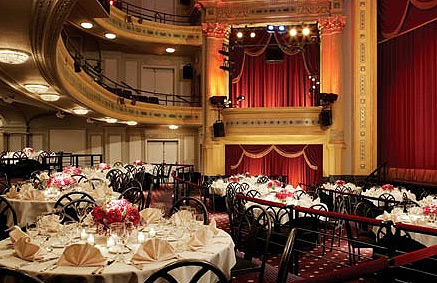
Courtesy: Millennium Broadway Hotel
Millennium
Broadway Hotel
The Scene:
The Millennium Broadway Hotel is located on Manhattan’s famous
Club Row, just half a block from revitalized Times Square. The recently
renovated property boasts 752 rooms and suites, and offers the ideal
location to enjoy midtown’s numerous attractions. The hotel is
home to the 102-year-old Hudson Theatre, the Broadway district’s
second oldest theatre. It is also the only hotel in New York with an
on-site meeting facility approved by the International Association of
Conference Centers.
The Backstory:
The property rests on the site that was once four tenement buildings
in a largely Irish and working class neighborhood known as Hell’s
Kitchen. Renamed Clinton by real estate speculators in the 80s, the
buildings were demolished in 1984 by developer Harry Macklowe, and construction
began on the mammoth property whose lobby would extend from 44th to
45th Streets. After completion, Macklowe lost the luxury property to
its current owners, Millennium Hotels.
The Look:
Dramatic murals, polished stainless steel, mahogany-paneled walls and
the rich black marble lobby take visitors back to the Art Deco period
between the two World Wars. The hotel’s newly renovated rooms feature
an elegant Asian-inspired “East Meets West’ concept, emphasizing
simplicity and fluidity of design. The rooms provide a tranquil haven
from the adrenaline-pumping activities on the streets outside.
Most Unique Amenity:
Primarily a venue for dramas and comedies, the Hudson Theater was home
to NBC's Tonight Show from 1954 to 1959. The theatre is now open to
bookings by groups, and makes a unique and colorful location for conferences
and meetings. The theatre has completed an extensive restoration, which
includes restoration of the its recently discovered Tiffany mosaics.
If Walls Could Talk:
In 1984, the developers had the area’s four buildings demolished
without obtaining demolition permits. They also neglected to turn off
water and gas lines into the buildings before demolition began. NYC
officials declared, “It is only a matter of sheer luck that there
was no gas explosion.” For future “If Walls Could Talk,”
check out the hotel’s famous Restaurant Charlotte, who has served
guests that include Mick Jagger, Bill Gates, Denzel Washington, John
Clayton and Diane Sawyer.
|




![]()













